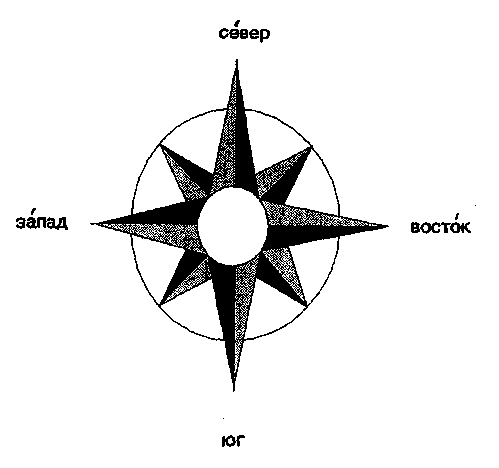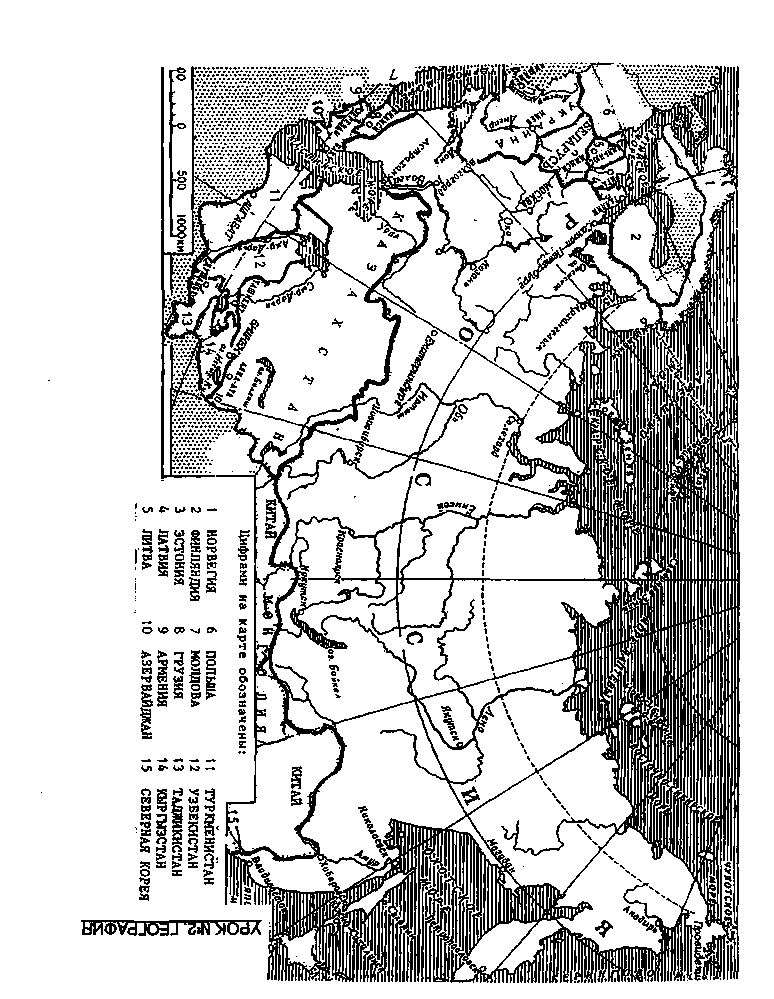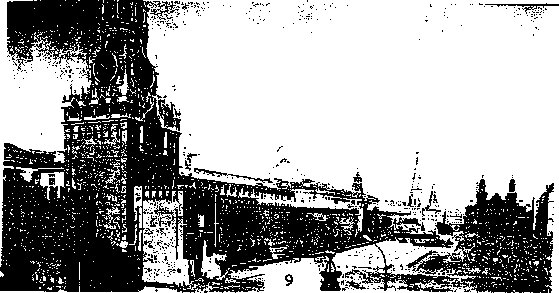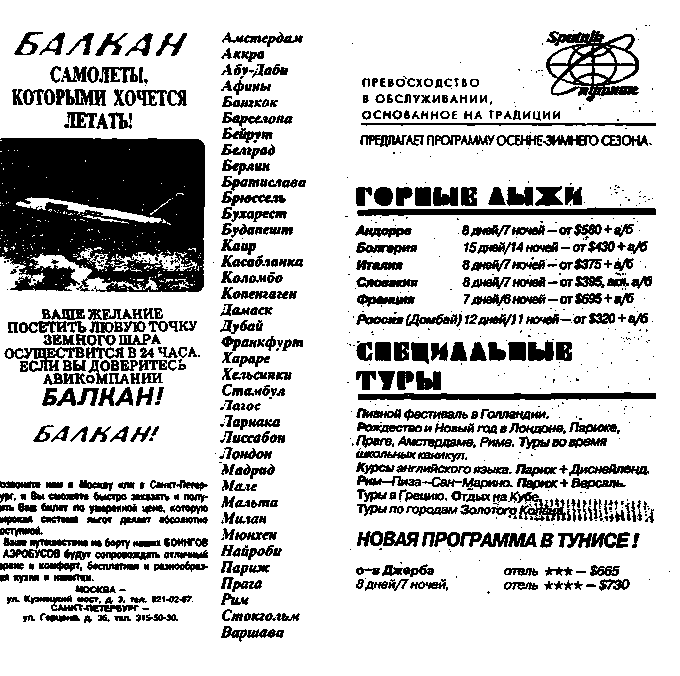Russia shares common borders with 14 different countries. They are listed here for you to read in Russian. After reading this list, see if you can find them on a map. Which of these are former republics of the Soviet Union?
| Норве́гия | По́льша | Казахста́н |
| Финля́ндия | Белору́ссия | Кита́й |
| Эсто́ния | Украи́на | Монго́лия |
| Ла́твия | Гру́зия | Се́верная Коре́я |
| Литва́ | Азербайджа́н |
Russia also borders on several large bodies of water. They are listed below:
| Балти́йское море | Се́верный Ледови́тый океа́н |
| Фи́нский зали́в | Ти́хий океа́н |
| Чёрное мо́ре | Япо́нское мо́ре |
| Азо́вское мо́ре | Охо́тское мо́ре |
| Каспи́йское мо́ре | Бе́рингово мо́ре |
Using the compass points below, tell your instructor where the 14 nations and the bodies of water are located:
| in the north | на се́вере |
| in the south | на юге |
| in the west | на за́паде |
| in the east | на восто́ке |

Russia is divided into a number of distinct areas, based on the geographic features of each region. Some of the most common of these are:
| Центра́льный район | Central (region) Russia |
| Ура́л | Ural Mountains |
| Пово́лжье | Volga River Valley |
| Сиби́рь | Siberia |
| Да́льний Восто́к | Far East |
The following cities are located in these geographic areas:
| 1 | Москва́ в Центра́льном райо́не. | Moscow is in Central Russia. |
| 2 | Екатеринбу́рг на Ура́ле | Yekaterinburg is in the Urals. |
| 3 | Волгогра́д в Пово́лжье. | Volgograd is in the Volga River Valley. |
| 4 | Новосиби́рск в Сиби́ри. | Novosibirsk is in Siberia. |
| 5 | Владивосто́к на Да́льнем Восто́ке. | Vladivostok is in the Far East. |
See if you can locate these cities on the map shown here.

After August 1991, the names of many Russian cities were changed:
| Present | Former |
|---|---|
| Санкт-Петербу́рг | Ленингра́д |
| Ни́жний Но́вгород | Го́рький |
| Екатеринбу́рг | Свердло́вск |
| Тверь | Кали́нин |
| Се́ргиев Поса́д | Заго́рск |
The same is true of numerous locations and landmarks in Moscow and other Russian cities:
| Present | Former |
|---|---|
| Тверска́я | у́лица Го́рького |
| Нови́нский бульва́р | у́лица Чайко́вского |
| Театра́льная пло́щадь | пло́щадь Свердло́ва |
| Лубя́нская пло́щадь | пло́щадь Дзержи́нского |
| Мане́жная пло́щадь | пло́щадь 50-ле́тия Октября́ |
But "Red Square" is still Red Square!
Кра́сная пло́щадь has been called Кра́сная (red) since the second half of the 17th century. The square was constructed towards the end of the 15th century (around the time of Columbus' discovery of America) when Tsar Ivan the Great Ива́н Вели́кий was building the magnificent cathedrals of the Kremlin Кремль, that walled fortress which was the heart of the city's defenses. Every major city in Russia would have had a Kremlin, but the Moscow one is by far the most famous.
The square was first called Торг (Trading Place) and was the site for some very lively commerce. Later, in the 16th century, it became known as Тро́ицкая (Trinity Square) in honor of the Trinity Cathedral which stood at the southern end of the square. In 1571 the square was renamed Пожа́р (The Fire) after the great fire of that year. Finally, the square was named Кра́сная when it was cleared of all the trading stalls at the end of the 17th century. At that time the word кра́сный (red) meant краси́вый (beautiful), and had nothing to do with the red brick of the Kremlin wall which runs along one of its sides.

Listen to the sentences your instructor will read aloud and write down in English any place names you recognize
1. ____________________
2. ____________________
3. ____________________
4. ____________________
5. ____________________
6. ____________________
7. ____________________
Listen to the statements your instructor will read aloud and indicate whether they are true (T) or false (F)
| 1. ____________________ | 4. ____________________ | 7. ____________________ |
| 2. ____________________ | 5. ____________________ | |
| 3. ____________________ | 6. ____________________ |
Practice writing place names in Russian as your instructor reads them aloud. He/she will read each one twice and then will write them on the board so that you can check your work.
1. ____________________
2. ____________________
3.. ____________________
4. ____________________
5. ____________________
6. ____________________
7. ____________________
Answer the following questions according to the model.
| Instructor: | Москва́ - столи́ца Росси́и? |
| Student: | Да, Москва́ - столи́ца Росси́и. |
О́сло - столи́ца Норве́гии?
Хе́льсинки - столи́ца Финля́ндии?
Пари́ж - столи́ца Фра́нции?
Бонн - столи́ца Герма́нии?
Варша́ва - столи́ца По́льши?
Отта́ва - столи́ца Кана́ды?
Вашингто́н - столи́ца Аме́рики?
Ло́ндон - столи́ца А́нглии?
Мадри́д - столи́ца Испа́нии?
Рим - столи́ца Ита́лии?
Answer the questions truthfully, according to the models:
| Instructor: | Пари́ж - столи́ца Фра́нции? |
| Student: | Да, Пари́ж - столи́ца Фра́нции. |
| Instructor: | Анкара́ - столи́ца И́ндии? |
| Student: | Нет, Но́вый Де́ли - столи́ца И́ндии. |
То́кио - столи́ца Кита́я? (Пекин)
Мани́ла - столи́ца Филиппи́н?
Мадра́с - столи́ца И́ндии? (Но́вый Де́ли)
Анка́ра - столи́ца Ира́на? (Тегера́н)
Ло́ндон - столи́ца А́нглии?
Стокго́льм - столи́ца Шве́ции?
Афи́ны - столи́ца Гре́ции?
Канбе́рра - столи́ца А́встрии? (Ве́на)
Каи́р - столи́ца Еги́пта?
Адди́с-Абе́ба - столи́ца Эфио́пии?
Тель-Ави́в - столи́ца Изра́иля?
Рим - столи́ца Ита́пии?
Мадри́д - столи́ца Португа́лии? (Лиссабо́н)
Гава́на - столи́ца Ку́бы?
Како́й? is the question word which asks: "Which?". Listen carefully as your instructor asks:
Како́й го́род столи́ца А́нглии?
Which city is the capital of England?
You'll answer:
Ло́ндон.
Continue, using the cities and countries given in Exercise 7. See how many you might be able to add on your own.
Что э́то? asks "What is this? What is that?" When answering, you'll begin your answer with Э́то... This is/That is...
Now your instructor will point to various cities on the map and will ask:
Что э́то? What is this? (pointing to Moscow)
You'll answer by naming the city, using this model:
Э́то Москва́. That is Moscow.
Answer the following questions substituting the appropriate pronoun for the noun.
| Instructor | Где Москва́? | Где Ло́ндон? | Где Чёрное мо́ре? |
| Student | Вот она́. | Вот он. | Вот оно́. |
| A. | В. |
| Где Ло́ндон? | Где Пра́га? |
| Где Пари́ж? | Где Тира́на? |
| Где Санкт-Петербу́рг? | Где Москва́? |
| Где Берли́н? | Где Софи́я? |
| Где Мадри́д? | Где Варша́ва? |
| Где Рим? | Где Ве́на? |
| Где Вашингто́н? | Где Братисла́ва? |
| Где го́род То́кио? | Где Я́лта? |
| Где го́род О́сло? | Где Гаа́га? |
| С. | D. |
| Где Росси́я? | Где Каспи́йское мо́ре? |
| Где Кана́да? | Где Чёрное мо́ре? |
| Где Япо́ния? | Где о́зеро Байка́л? |
| Где Эфио́пия? | Где Балти́йское мо́ре? |
Take a look at the following advertisements. Pick out all words which are familiar to you. Any guesses as to what the ads are all about? Ask your instructor if you need help.

Your instructor wants you to show where various places are on the map. He/she will ask you:
Покажи́те...
Покажи́те Во́лгу.
Покажи́те Сиби́рь.
Покажи́те Ти́хий океа́н.
Покажи́те Фи́нский зали́в.
Покажи́те Каспи́йское мо́ре.
Покажи́те Се́верный Ледови́тый океа́н.
Покажи́те Чёрное мо́ре.
Read through this list of Russian cities and sort them according to the regions
in the table below. Use the map, or ask your instructor for help.
Ирку́тск, Владивосто́к, Хаба́ровск, Пермь, Сама́ра, Челя́бинск, Москва́, Но́вгород, Екатеринбу́рг, Петропа́вловск, Оренбу́рг, Тверь, Красноя́рск, Кострома́, Новосиби́рск, Влади́мир, Сара́тов, Яросла́вль.
| Сиби́рь | |
| Да́льний Восто́к | |
| Пово́лжье | |
| Ура́л | |
| Центра́льный райо́н |
| Росси́я больша́я страна́. | Russia is a large country. |
| Кли́мат Росси́и разнообра́зный:на Кра́йнем Се́вере - аркти́ческий. | The climate of Russia is varied:in the Far North - arctic. |
| На ю́ге, в Со́чи -субтропи́ческий. | In the south, in Sochi - subtropical. |
| В европе́йской ча́сти Росси́и и в Сиби́ри кли́мат уме́ренный, континента́льный. | In the European part of Russia and in Siberia the climate is moderate, continental. |
| На за́паде - мя́гкий, на восто́ке и се́веро-восто́ке -о́чень холо́дный и суро́вый. | In the west it is mild and in the east and northeast - very cold and severe. |
| На Да́льнем Восто́ке кли́мат морско́й. | In the Far East the climate is maritime. |
Examine the weather forecasts below and:
a. read the names of the cities and the legend (explanation of symbols).
b. tell where it is sunny со́лнечно, overcast о́блачно, raining дождь or snowing снег.

| Росси́я | Москва́ - столи́ца России. В Росси́и живу́т ру́сские. |
| Украи́на | Киев - столи́ца Украи́ны. В Украи́не живу́т украи́нцы. |
| Ла́твия | Ри́га - столи́ца Ла́твии. В Ла́твии живу́т латыши́́́́́. |
| Литва́ | Ви́льнюс - столи́ца Литвы́. В Литве́ живу́т лито́вцы. |
| Эсто́ния | Та́ллин - столи́ца Эсто́нии. В Эсто́нии живу́т эсто́нцы. |
| Молда́вия | Кишинёв - столи́ца Молда́вии. В Молда́вии живу́т молдава́не. |
| Белору́ссия | Минск - столи́ца Белору́ссии. В Белору́ссии живу́т белору́сы. |
| Гру́зия | Тбилиси - столи́ца Гру́зии. В Груз́ии живу́т грузи́ны. |
| Арме́ния | Ерева́н - столи́ца Арме́нии. В Арме́нии живу́т армя́не. |
| Азербайджа́н | Баку́ - столи́ца Азербайджа́на. В Азербайджа́не живу́т азербайджа́нцы. |
| Узбекиста́н | Ташке́нт - столи́ца Узбекиста́на. В Узбекиста́не живу́т узбе́ки. |
| Казахста́н | Алма́-Ата́ - столи́ца Казахста́на. В Казахста́не живу́т каза́хи. |
| Туркме́ния | Ашхаба́д - столи́ца Туркме́нии. В Туркме́нии живу́т туркме́ны. |
| Таджикиста́н | Душанбе́ - столи́ца Таджикиста́на. В Таджикиста́не живу́т таджи́ки. |
| Кирги́зия | Бишке́к - столи́ца Кирги́зии. В Кирги́зии живу́т кирги́зы. |
Fill in the blanks, orally.
| 1. ____________________ | столи́ца Белору́ссии. |
| 2. ____________________ | столи́ца Гру́зии. |
| 3. ____________________ | столи́ца Кирги́зии. |
| 4. ____________________ | столи́ца Туркме́нии. |
| 5. ____________________ | столи́ца Литвы́. |
| 6. ____________________ | столи́ца Украи́ны. |
| 7. ____________________ | столи́ца Узбекиста́на. |
Fill in the blanks, orally.
| 1. В Арме́нии живу́т | ____________________ |
| 2. В Азербайджа́не живу́т | ____________________ |
| 3. В Молда́вии живу́т | ____________________ |
| 4. В Эсто́нии живу́т | ____________________ |
| 5. В Таджикиста́не живу́т | ____________________ |
| 6. В Казахста́не живу́т | ____________________ |
| 7. В Ла́твии живу́т | ____________________ |
Answer the following questions according the models:
| Instructor: | Таджи́ки живу́т в Таджикиста́не? |
| Student: | Да, они́ живу́т в Таджикиста́не. |
| Instructor: | Эсто́нцы живу́т в Ла́твии? |
| Student: | Нет, они́ живу́т в Эсто́нии. |
| 1. | Ру́сские живу́т в Росси́и? | ____________________ |
| 2. | Грузи́ны живу́т в Гру́зии? | ____________________ |
| 3. | Каза́хи живу́т в Казахста́не? | ____________________ |
| 4. | Молдава́не живу́т в Белору́ссии? | ____________________ |
| 5. | Узбе́ки живу́т в Ла́твии? | ____________________ |
| 6. | Туркме́ны живу́т в Кирги́зии? | ____________________ |
| 7. | Азербайджа́нцы живу́т в Литве́? | ____________________ |
Of course, as you well know, the Newly Independent States are home to many nationalities. The above exercise, and the ones following, in no way suggest that these new countries have entirely homogeneous populations.
Using the map, indicate the home countries of the given nationalities.
Покажи́те где живу́т укра́инцы.
Покажи́те где живу́т узбе́ки.
Покажи́те где живу́т армя́не.
Покажи́те где живу́т ру́сские.
Покажи́те где живу́т белору́сы.
Покажи́те где живу́т лито́вцы.
Using the map, indicate the capitals of the following countries:
Покажи́те столи́цу Казахста́на.
Покажи́те столи́цу Молда́вии.
Покажи́те столи́цу Туркме́нии.
Покажи́те столи́цу Украи́ны.
Покажи́те столи́цу Росси́и.
Покажи́те столи́цу Арме́нии.
Listen to the following statements your instructor will read aloud. Indicate whether they are true (пра́вильно) or false (непра́вильно):
В Кирги́зии живу́т кирги́зы?
Таджи́ки живу́т в Таджикиста́не?
В Узбекиста́не живу́т узбе́ки?
Ру́сские живу́т в Азербайджа́не?
В Эсто́нии живу́т каза́хи?
Латыши́ живу́т в Ла́твии?
Match the countries with their capitals.
| Эсто́ния | Ерева́н |
| Таджикиста́н | Ри́га |
| Росси́я | Минск |
| Казахста́н | Тбили́си |
| Литва́ | Бишке́к |
| Гру́зия | Ки́ев |
| Туркме́ния | Ви́льнюс |
| Молда́вия | Москва́ |
| Ла́твия | Душанбе́ |
| Узбекиста́н | Ашхаба́д |
| Арме́ния | Кишинёв |
| Украи́на | Та́ллин |
| Азербайджа́н | Баку́ |
| Белору́ссия | Алма́-ата́ |
| Кирги́зия | Ташке́нт |
Russian is an inflected language which simply means that nouns (and their modifiers) will change their shape to indicate a change of function within the sentence. A noun may function as a subject, an indirect object or direct object or the object of a preposition. In each instance it will change its ending to inform you of its particular role.
Each of these functions is indicated by a set of endings (1 each for each of the genders and 1 for plural), which are grouped into CASES:
| 1. Nominative | names the subject (who? what?) |
| 2. Genitive | shows possession (whose?) |
| 3. Dative | indicates the indirect object, recipient of the action (to whom? to what?) |
| 4. Accusative | indicates the direct object (whom? what?) |
| 5. Instrumental | indicates instrument or means; or accompaniment (how? with what? with whom?) |
| 6. Locative/Prepositional | shows location (where?); indicates the object of the preposition (about whom? about what?) |
All Russian nouns belong to one of three grammatical genders: masculine, neuter or feminine. Do not confuse gender with sex; the word for table in Russian is a masculine gender noun, but there's nothing male about the object; book in Russian is a feminine gender noun, but there's nothing inherently female about it. However, nouns referring to male beings will (usually) be masculine gender; those referring to female beings will be feminine gender.
In most cases, the gender of the noun can be determined by its ending. The table below illustrates this:
| MASCULINE | NEUTER | FEMININE |
| end in a consonant or-b | end in -о or -е | end in -а, -я or -ь |
па́спорт автомоби́ль портфе́ль |
о́зеро мо́ре пальто́́ |
ви́за фами́лия Сиби́рь |
| он | оно́ | она́ |
Adjectives agree with the nouns they modify in gender, number and case. This means that when a singular feminine noun is in the nominative case (the subject of the sentence), the adjective that describes that noun must be nominative, singular, feminine. Since the noun and adjective do not necessarily stand together in the sentence, agreement is especially important. Agreement in the nominative may look like this:
| OН | ОНО́ | ОНА́ |
но́вый дом хоро́ший студе́нт |
но́вое зда́ние хоро́шее вино́ |
но́вая кварти́ра хоро́шая студе́нтка |
| ОНИ́ | ОНИ́ | ОНИ́ |
но́вые дома́ хоро́шие студе́нты |
но́вые зда́ния хоро́шие ви́на |
но́вые кварти́ры хоро́шие студе́нтки |
Russian uses pronouns in much the same way English does; they take the place of, or refer back to nouns. The table below shows the correspondence between Russian and English pronouns:
| я | I |
| ты | you (sing, and informal) |
| он/она́/оно́ | he/she/it |
| мы | we |
| вы | you (pi. and formal) |
| они́ | they |
As you can see by this table, Russian has two pronouns for the second person you. Ты is informal and singular; вы is formal and/or plural. (See the comments on ты and вы in Lesson 3).
As in English, Russian pronouns change form as their function changes in the sentence. Take a look at the following sentences:
I know you.
You know me.
I changes to me when it switches from the role of subject to the role of object.
Я зна́ю вас.
Вы зна́ете меня́.
Вот is used in Russian in the sense of "Here is..." when pointing to something or someone. For example:
| -Где бага́ж? | Where's the luggage? |
| -Вот он. | Неге it is. |
| -Где Ли́нда? | Where's Linda? |
| -Вот она́. | Here she is. |
The verb жить [to live] appears in two forms in this lesson: (он/она) живёт and (они́) живу́т. Verbs in Russian, as in English, agree with their subjects in terms of person (I, you, he/she, we, they) and number (He lives, vs They live.). The two forms indicated here are for a singular subject and a plural subject, respectively.
| Он живёт в Москве́. | Не lives in Moscow. |
| Она́ живёт в Ки́еве. | She lives in Kiev. |
| Они́ живу́т в Аме́рике. | They live in America. |
| Кто живёт в Украи́не? | Who lives in Ukraine? |
| В Украи́не живу́т украи́нцы. | Ukrainians live in Ukraine. |
Here is the verb жить in all forms of the present tense:
| жить / to live | |
| я живу́ | мы живём |
| ты живёшь | вы живёте |
| он живёт | они живу́т |
Како́й, како́е, кака́я, каки́е is a question word which asks: «Which?» or «What kind of? ...» It is an adjective and will agree in gender, number and case with the word it modifies. The first three forms shown here are the masculine, neuter and feminine forms, respectively. The fourth is the plural. Compare these forms to those of the adjectives in the table on page 29.
| OH | OHÓ | ОНА́ | ОНИ́ |
| како́й | како́е | кака́я | каки́е |
The nominative case is used to indicate the subject of a sentence. It is also used for other nouns in the sentence which give more information about the subject. As it is the dictionary form for nouns and adjectives, you should memorize nouns and adjectives in their nominative case forms.
| Я иду́ в теа́тр. | I am going to the theater. |
| Кни́га на столе́. | The book is on the table. |
| Вот дом. | There is the house. |
| Э́то моя́ ру́чка. | This is my pen. |
| Мой брат - инжене́р. | My brother is an engineer. |
| В институ́те рабо́тают америка́нские фи́зики. | American physicists work in the institute. |
Because Russian has cases, word order in a sentence is less important than it is in English. The subject [that noun plus its modifiers in the nominative case] can come at the beginning, in the middle or at the end of the sentence. Knowing the nominative case endings for nouns and adjectives will help you find the subject of the sentence more quickly.
Adjectives are linked to their nouns by their endings. The adjective may stand in front of, after, or at a distance from the noun it modifies. You can always find the adjective which modifies a noun by looking for the one whose ending matches in gender, number, and case that of the noun.
Э́то Бе́лый дом.
Она́ учи́тельница хоро́шая, о́пытная.
Ру́сский язы́к о́чень интере́сный, но тру́дный.
Table 2.1. Useful words and expressions
| в | in, inside |
| восто́к; на восто́ке | east; in the east |
| вот | here |
| Где? | Where? |
| го́род | city, town |
| Добро́ пожа́ловать! | Welcome |
жить (я живу́, вы живёте, они живу́т) | to live |
| за́пад; на за́паде | west; in the west |
| како́й/како́е/кака́я/каки́е | what kind of; which; which one(s) |
| Кто? | who |
| Кто э́то? | Who is that? |
| на | on; at; in |
| он, она́, оно́, они́ | he; she; it; they |
| Покажи́те... | Show... |
| пого́да | weather |
| се́вер; на се́вере | north; in the north |
| столи́ца | capital |
| что | what |
| Что э́то? | What is that/this |
| э́то | this/that |
| юг; на ю́ге | south; in the south |